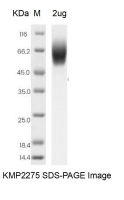Service Line:+86-022-82164980
Address:FL-4, Building A5, International Enterprise Community, Tianjin, China
Email:[email protected]
| Catalog Number | KMP2275 |
|---|---|
| Product Name | Human Biotinylated ROR1 Protein, His Tag, Avi Tag |
| Product Description | The Human Biotinylated ROR1 Protein(KMP2275) is produced in HEK293 Cells and the target gene encoding Gln30-Glu403 is expressed with a 6His, Avi tag at the C-terminus. |
| Molecular Weight | 42.82 kDa |
| Alias | Inactive tyrosine-protein kinase transmembrane receptor ROR1, ROR1 |
| Species | Human |
| Host | HEK293 Cells |
| Size | 50ug, 100ug, 200ug |
| Purification | Affinity purification |
| Purity | >95% as determined by SDS-PAGE |
| Endotoxin | <1.0 EU/ug determined by the LAL method |
| Buffer | PBS, pH7.4 |
| Uniprot | Q01973 |
| SDS-PAGE |  |
| Function | Has very low kinase activity in vitro and is unlikely to function as a tyrosine kinase in vivo (PubMed:25029443). Receptor for ligand WNT5A which activate downstream NFkB signaling pathway and may result in the inhibition of WNT3A-mediated signaling (PubMed:25029443, PubMed:27162350). In inner ear, crucial for spiral ganglion neurons to innervate auditory hair cells (PubMed:27162350). |
| Background | Receptor tyrosine kinase-like orphan receptor 1(ROR1), also known as neurotrophic tyrosine kinase, it is a member of the ROR family within receptor tyrosine kinases(RTK) superfamily. Human ROR1 is a type I transmembrane protein with 937 amino acids(aa) in length. It contains a 29 aa signal sequence, a 377 aa extracellular domain(ECD), a 21 aa transmembrane segment, and a 510 aa cytoplasmic region. ROR1 expressed strongly in human heart, lung and kidney, but weakly in the CNS. At developmental stage, it expressed at high levels during early embryonic development. ROR1 has been shown to have very low kinase activity in vitro and is unlikely to function as a tyrosine kinase in vivo. It may act as a receptor for wnt ligand WNT5A which may result in the inhibition of WNT3A-mediated signaling. |
| Storage | Aliquot and store at -20℃ to -80℃. Avoid repeated freezing and thawing cycles. |
| Note | This product is for research use only. |
| References | 1.PLoS ONE 9:E102695-E102695 (2014) 2.Proc. Natl. Acad. Sci. U.S.A. 113:5993-5998 (2016) |